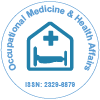Musculoskeletal Disorders: A Growing Occupational Health Concern
Received: 01-May-2025 / Manuscript No. omha-25-171462 / Editor assigned: 03-May-2025 / PreQC No. omha-25-171462 / Reviewed: 17-May-2025 / QC No. omha-25-171462 / Revised: 22-May-2025 / Manuscript No. omha-25-171462 / Published Date: 29-May-2025 DOI: 10.4172/2329-6879.1000582
Introduction
Musculoskeletal disorders (MSDs) are a group of conditions that affect the muscles, bones, tendons, ligaments, joints, and supporting structures of the body. They are among the most common work-related health issues globally, often leading to pain, disability, reduced productivity, and increased healthcare costs. MSDs can develop gradually over time due to repetitive strain, poor posture, or overexertion, or they may result from sudden injuries such as sprains or fractures. Because of their widespread impact on both individuals and organizations, addressing MSDs has become a priority in occupational health and public health systems [1,2].
Discussion
MSDs encompass a wide range of conditions, including lower back pain, neck strain, carpal tunnel syndrome, tendonitis, osteoarthritis, and rotator cuff injuries. These disorders often arise from daily activities involving repetitive motion, awkward postures, lifting heavy objects, or prolonged sitting and standing. For example, office workers are prone to neck and wrist problems due to extended computer use, while construction and healthcare workers may develop back and shoulder injuries from physically demanding tasks [,,,].
The impact of MSDs extends beyond physical discomfort. Chronic pain and mobility limitations can affect mental well-being, leading to stress, fatigue, and reduced quality of life. From an economic standpoint, MSDs contribute significantly to absenteeism, presenteeism (working while unwell), compensation claims, and long-term disability. According to global health reports, MSDs are one of the leading causes of disability-adjusted life years (DALYs) and place a heavy burden on healthcare systems [,].
Risk factors for MSDs can be classified into physical, organizational, and individual categories. Physical risks include repetitive movements, forceful exertions, vibrations, and poor workstation design. Organizational factors such as excessive workloads, lack of rest breaks, and insufficient training can exacerbate the problem. On an individual level, age, obesity, sedentary lifestyle, and pre-existing conditions increase susceptibility to MSDs [,].
Prevention and management of MSDs require a multifaceted approach. Ergonomic interventions are crucial—this includes redesigning workplaces to promote neutral body postures, using adjustable chairs and desks, and providing mechanical aids for lifting. Regular training and awareness programs can help workers recognize early symptoms and adopt safe practices. Encouraging physical activity and exercise improves muscle strength and flexibility, reducing vulnerability to injuries. In healthcare settings, early diagnosis and treatment—such as physiotherapy, medication, or workplace modifications—can prevent minor problems from progressing into chronic disorders.
Conclusion
Musculoskeletal disorders represent a significant challenge for both individuals and organizations, affecting health, productivity, and economic stability. While they are common and often disabling, most MSDs are preventable through proactive measures such as ergonomic design, worker education, early intervention, and supportive workplace policies. By prioritizing prevention and integrating health-focused strategies into daily operations, employers and healthcare systems can reduce the burden of MSDs and promote safer, healthier, and more sustainable work environments. Ultimately, addressing musculoskeletal disorders is not only about preventing pain but also about enhancing overall quality of life and workplace well-being.
References
- Jomezadeh N, Babamoradi S, Kalantar E, Javaherizadeh H (2014) Isolation and antibiotic susceptibility of Shigella species from stool samplesamong hospitalized children in Abadan, Iran. Gastroenterol Hepatol Bed Bench 7: 218.
- Sangeetha A, Parija SC, Mandal J, Krishnamurthy S (2014) Clinical and microbiological profiles of shigellosis in children. J Health Popul Nutr 32: 580.
- Ranjbar R, Dallal MMS, Talebi M, Pourshafie MR (2008) Increased isolation and characterization of Shigella sonnei obtained from hospitalized children in Tehran, Iran. J Health Popul Nutr 26: 426.
- Zhang J, Jin H, Hu J, Yuan Z, Shi W, Yang X, et al. (2014) Antimicrobial resistance of Shigella spp. from humans in Shanghai, China, 2004–2011. Diagn Microbiol Infect Dis 78: 282–286.
- Pourakbari B, Mamishi S, Mashoori N, Mahboobi N, Ashtiani MH, et al. (2010) Frequency and antimicrobial susceptibility of Shigella species isolated in children medical center hospital, Tehran, Iran, 2001–2006. Braz J Infect Dis 14: 153–157.
- Von-Seidlein L, Kim DR, Ali M, Lee HH, Wang X, Thiem VD, et al. (2006) A multicentre study of Shigella diarrhoea in six Asian countries: Disease burden, clinical manifestations, and microbiology. PLoS Med 3: e353.
- Germani Y, Sansonetti PJ (2006) The genus Shigella. The prokaryotes In: Proteobacteria: Gamma Subclass Berlin: Springer 6: 99-122.
- Aggarwal P, Uppal B, Ghosh R, Krishna Prakash S, Chakravarti A, et al. (2016) Multi drug resistance and extended spectrum beta lactamases in clinical isolates of Shigella: a study from New Delhi, India. Travel Med Infect Dis 14: 407–413.
- Taneja N, Mewara A (2016) Shigellosis: epidemiology in India. Indian J Med Res 143: 565-576.
- Farshad S, Sheikhi R, Japoni A, Basiri E, Alborzi A (2006) Characterizationof Shigella strains in Iran by plasmid profile analysis and PCR amplification of ipa genes. J Clin Microbiol 44: 2879–2883.
Citation: Laura C (2025) Musculoskeletal Disorders: A Growing Occupational Health Concern. Occup Med Health 13: 582. DOI: 10.4172/2329-6879.1000582
Copyright: © 2025 Laura C. This is an open-access article distributed under the terms of the Creative Commons Attribution License, which permits unrestricted use, distribution, and reproduction in any medium, provided the original author and source are credited.
Select your language of interest to view the total content in your interested language
Share This Article
Recommended Journals
Open Access Journals
Article Tools
Article Usage
- Total views: 115
- [From(publication date): 0-0 - Dec 09, 2025]
- Breakdown by view type
- HTML page views: 90
- PDF downloads: 25
